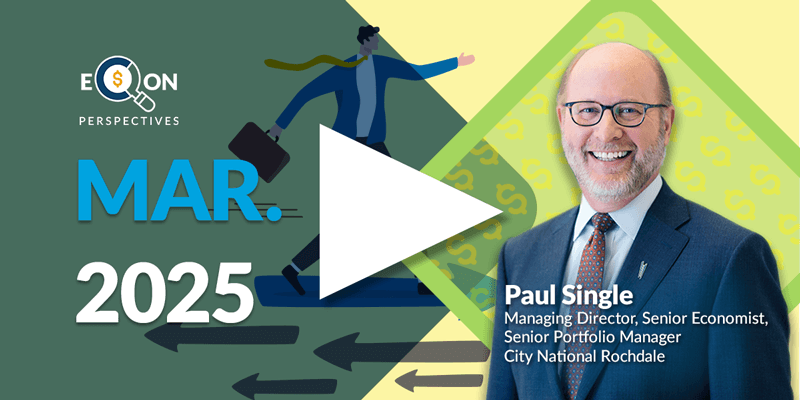-
Market Perspectives
Next Chapter
November 2024
- Filename
- Market Perspectives NOVEMBER 2024.pdf
- Format
- application/pdf
TRANSCRIPT
We are post-election. Now we can focus on arguing about things like whether to roast or deep fry the turkey.
In a reversal from the 2022 midterms, we got a red wave. Republicans will control the White House, the Senate, 53 to 47, and they just recently secured their 219th seat in the House, giving them a majority in both chambers. So, smooth sailing for the new agenda. Correct?
Not so fast.
Yes, there will be changes, and yes, they will impact the economy and financial markets. But one shouldn't assume quick, easy, and full manifestation of the incoming administration's agenda. The Republican majority is by no means a unified decision-making body. There are divergent and conflicting views within the leadership. Meaning, it may not be as easy for President Trump to get through his agenda in the form he wishes.
That said, let's focus on the potential policy changes for Trump's second term and the potential economic and financial market impacts. We'll look at taxes, tariffs, higher federal debt, and immigration reform.
Starting with taxes, changes to tax policy under Trump will put more money in consumer and corporate bank accounts. Higher-income households should see a larger relative benefit. Spending will likely increase, as will corporate profits.
Election: Corporate Taxes

Chart Federal Corporate Tax Rate: ■ 15% is an alternative proposed rate.
Source: Tax Foundation, as of October 2024.
Information is subject to change and is not a guarantee of future results.
Charts 1 & 2, 1:42— In addition to income tax rates, long-term capital gains rates could drop as part of Trump's tax overhaul, further putting more money in investors' pockets. He has proposed further lowering the corporate tax rate from the current 21% level, perhaps down to as low as 15%. Over time, these forces can be inflationary, which increases the probability of higher interest rates higher than we previously expected.
Election Impact: Taxes

Source: Tax Foundation, as of October 2024.
Information is subject to change and is not a guarantee of future results.
Charts 3 & 4, 2:10— Trump has proposed significant increases in tariffs on foreign imports. Such increases could offset some of the aforementioned tax benefits, particularly for individuals. Estimates are shown in the chart on the left comparing the after-tax income impact of proposed taxes and tariffs. Lower-income households would feel a relatively greater negative impact.
The Federal Debt Is Large but Manageable for Now

Sources: Bloomberg, as of May 2024; International Monetary Fund, as of Q2 2022.
Information is subject to change and is not a guarantee of future results.
Charts 5 & 6, 2:37— Moving to the third item, the federal debt. Now, regardless of the outcome of the election, we were likely going to see the debt increase. It remains to be seen whether cost savings from government reform, combined with revenue from tariffs, will offset the reduction in revenue from tax cuts. But fiscal policy will be in a stimulative mode. The debt is still manageable for now, and the level is consistent with that of other developed nations. As a reminder, a decade-long shift has moved our debt mostly into domestic hands, with foreign holders now accounting for about one third.
Estimated Economic Impact
Relative to CBO 2028 Baseline

Source: Bloomberg Economics, as of October 2024
Information is subject to change and is not a guarantee of future results.
Chart 7, 3:16— Finally, we shift to immigration reform — a high-priority item for the incoming administration. There are various scenarios. as depicted here, but the takeaway is that immigration reform will have an impact on the labor force as the population changes. Fewer workers generally means lower GDP. Larger hits to the labor force can be inflationary initially, but eventually deflationary if aggregate demand drops.
Economic Impacts of Potential Policy Changes

Source: CNR Research, as of October 2024.
Information is subject to change and is not a guarantee of future results.
Chart 8, 3:47— This chart serves as a good summary in terms of the possible impacts to economic growth, inflation, interest rates, and corporate profits. Trade and tax policy could lead to higher inflation and interest rates. Anticipated inflation pressures could stall or reverse the downward path we've experienced this year. As a result, interest rate forecasts may need to be revised higher. Policy may also increase growth. And we are likely to see an increase in government debt.
Expectations for future moves by the Fed have already started to adjust. There is now some debate over whether we will see another rate cut at the December meeting. In addition, expectations for the duration of this current cutting cycle are being trimmed, with some expecting the Fed to stop cutting in mid-2025.
Obviously, there’s a lot to monitor as the new administration takes shape leading up to Inauguration Day — and, after that, as we see how much of the agenda gets through in the first 100 days and over the first year. For now, the underlying fundamentals remain strong, and we believe the U.S. remains the best market.
Important Information
The views expressed represent the opinions of City National Rochdale, LLC (CNR) which are subject to change and are not intended as a forecast or guarantee of future results. Stated information is provided for informational purposes only, and should not be perceived as personalized investment, financial, legal or tax advice or a recommendation for any security. It is derived from proprietary and non-proprietary sources which have not been independently verified for accuracy or completeness.
While CNR believes the information to be accurate and reliable, we do not claim or have responsibility for its completeness, accuracy, or reliability. Statements of future expectations, estimates, projections, and other forward-looking statements are based on available information and management's view as of the time of these statements. Accordingly, such statements are inherently speculative as they are based on assumptions which may involve known and unknown risks and uncertainties. Actual results, performance or events may differ materially from those expressed or implied in such statements.
Past performance or performance based upon assumptions is no guarantee of future results.
All investing is subject to risk, including the possible loss of the money you invest. As with any investment strategy, there is no guarantee that investment objectives will be met and investors may lose money. Diversification does not ensure a profit or protect against a loss in a declining market.
Equity investing strategies & products. There are inherent risks with equity investing. These risks include, but are not limited to stock market, manager or investment style. Stock markets tend to move in cycles, with periods of rising prices and periods of falling prices.
Fixed Income investing strategies & products. There are inherent risks with fixed income investing. These risks include, but are not limited to, interest rate, call, credit, market, inflation, government policy, liquidity or junk bond risks. When interest rates rise, bond prices fall. This risk is heightened with investments in longer-duration fixed income securities and during periods when prevailing interest rates are low or negative.
City National Rochdale, LLC is an SEC-registered investment adviser and wholly-owned subsidiary of City National Bank. Registration as an investment adviser does not imply any level of skill or expertise. City National Bank is a subsidiary of the Royal Bank of Canada.
© 2024 City National Rochdale, LLC. All rights reserved.
Index Definitions
The Bloomberg Barclays U.S. Corporate High Yield Index is an unmanaged, U.S.-dollar-denominated, nonconvertible, non-investment-grade debt index. The index consists of domestic and corporate bonds rated Ba and below with a minimum outstanding amount of $150 million.
Stay Informed.
Get our Insights delivered straight to your inbox.
Put our insights to work for you.
If you have a client with more than $1 million in investable assets and want to find out about the benefits of our intelligently personalized portfolio management, speak with an investment consultant near you today.
If you’re a high-net-worth client who's interested in adding an experienced investment manager to your financial team, learn more about working with us here.



